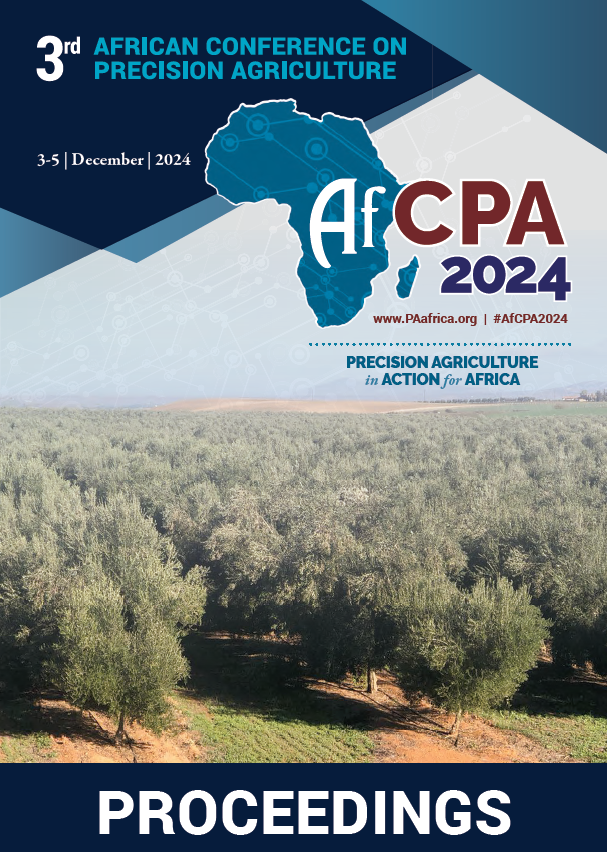Download the Conference Proceedings
Proceedings
Authors
| Filter results9 paper(s) found. |
|---|
1. Spatial Interpolation for Mapping Hydraulic Soil Properties in GIS EnvironmentSoil water information is an essential input for environmental, hydrological or land surface models. There is a need for reliable soil water information with current coverage in the area. A number of 60 soil profiles data were evaluated for the performance of estimates inverse distance weighting to map some of the soil quality properties. soil profiles were used for the application of geostatistics. Maps with the investigated coverage were produced with the soil information available about soil... M.A. Abdelrahman, A.M. Saleh, M.M. El sharkawy, E. Farg, S.M. Arafat |
2. Development of Canopy Mapping System of Asian pears (Pyrus pyrifolia Naka) Using Terrestrial Laser ScanningIn this paper, the canopy mapping system (CMS) of Asian pears for estimating yield during Bud thinning and Pruning operations using point cloud data was proposed. Bud thinning and Pruning in Asian pear (Pyrus pyrifolia Naka) is necessary to ensure quality and yield but is time-consuming and heavily depends on work knowledge. This study described a method of estimating the number of fruits through the length of a branch based on remote sensing. The CMS would be useful to support more efficient... E. Morimoto, J. Lee, K. Nonami, I. Matumura, M. Ikebe, S. Sato |
3. Determining Nutrients rates for Maize, Rice, Cotton, and Tomato in Dry Savannah zone of Togo based on site specific nutrient management approachInadequate fertilizer application limits crop yields and lead to the soil fertility depletion. This study aims at formulating nutrients rates recommendations for main the crops in dry savannah zone of Togo. Site specific nutrient management approach based on spatial variations in nutrients status, crops nutrients requirement and average crop yields under field conditions was used to determine recommendations rates in N, P and K. For maize cropping, nutrients needs are 94 kgN.ha-1, 42... |
4. Application of precision agriculture technologies in grazing: example of goats browsing in forest rangelands of Northern MoroccoThe aim of this study was to characterize patterns of grazing behavior of goats in a Mediterranean forest rangeland. We conducted a one-year study in the Chefchaouen region, Northern Morocco, during two contrasting seasons (spring and summer) using new technological tools. Eight goats were simultaneously fitted with GPS collars and sensors for 3 days during each season. A calibration study and classification tree analysis were used to predict other grazing activities of goats (eating, walking,... Y. Chebli, S. El otmani, M. Chentouf, J. Hornick, J. Cabaraux |
5. Performance agronomique et économique de différentes stratégies de gestion de la fertilité du sol sous culture de soja (Glycine max L. Merril) dans la zone littorale du Togo.Ce travail a pour objectif de valoriser les émondes de deux légumineuses arbustives et quelques fertilisants organiques pour améliorer la production du soja. Afin de parvenir à cet objectif, les paramètres comme la masse de mille graines, les rendements en gousses, en graines, en fanes du soja et autres ont été déterminés. L’étude a eu lieu à la Station d’Expérimentation Agronomique de Lomé (SEAL)... K.M. Amouzouvi, K.E. Ozou, L. Kolani, K.A. Amouzouvi, J.M. Sogbedji |
6. Keynote 2 - Satellite Earth Observations and Machine Learning for Agricultural Monitoring in Sub-Saharan AfricaFood security is one of the most pressing issues faced by many African countries today. 2019 brought further shocks and setbacks to crop production across Africa. Farmers in East Africa, for example, faced more devastating floods, the most severe (and still ongoing) desert locust infestation in 70 years, and of course the COVID-19 pandemic, which has affected every sector and every food system... C. Nakalembe |
7. Potato Yield Prediction Using Multi-temporal Sentinel-2 Data and Multiple Linear RegressionTraditional potato growth models have a number of flaws, i.e., the cost of data collection, quality of input data, and the absence of spatial information in some cases. To address these challenges, we created a multiple linear regression model (MLRM) that uses the multi-temporal Sentinel-2 derived indices to predict potato yield. Along the growing season (from October 2019 to February 2020) eight Sentinel-2 imageries were collected, afterwards, the normalized difference vegetation index (NDVI)... M.E. Amin, M.A. Abdelfattah, E.S. Mohamed, A.A. Belal, M. Nabil, A.G. Mahmoud |
8. Using Precision Technologies to Monitor the Grazing Activities of Goat in a North African WoodlandIn the north of Africa, browsing on natural pastures is the main source of feed for domestic goats. Livestock farming, particularly grazing goats, constitutes the prevalent agricultural activity in the mountainous areas of Morocco. Data on animal behavioral activities are essential for understanding their feeding and their interaction with the environment in order to define the optimal management intervention strategies. The recent development of precision farming technologies and the increasing... Y. Chebli, M. Chentouf, J. Cabaraux, S. El otmani |
9. Evaluating the Impact of Seasonal Weather Variability on Soil Moisture Conservation Under Mulching Systems for Date Palm Production in OasesSoil moisture is an essential parameter that governs crop production and soil health. Therefore, the critical role of soil moisture cannot be overstated in sustaining agriculture, especially in arid and semi-arid regions. Date palm production not only plays a vital role in economic and nutritional purposes in many arid areas but also plays important roles in creating favorable microclimates for agriculture and protecting lands from desertification. This study proposes an innovative approach... U. Safi, O. Abdallah , A. Sabri |
